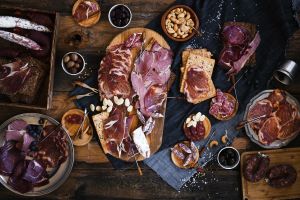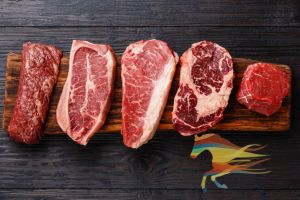5 things to consider before launching your meat box business
The most common farm diversification option for any meat-producing livestock farmer is a meat box business or other forms of direct sale. This can come in many forms; often smaller family farms will start by simply offering to sell a portion of a carcass to locals, for example, half a lamb or for beef farms, this might be a quarter of a carcass.
However, this method doesn’t work effectively when looking to scale the business. To successfully scale a meat box business, you need to consider how best to process the carcass to ensure you have a range of meat products or cuts to offer that are recognisable and manageable for the average consumer. Let's look at how you can scale your farm business and step up from causal direct meat sales to a more profitable and scalable meat box farm diversification.
Many farms we work with haven’t fully considered all the processes involved in selling their meat directly to consumers. We regularly come across farmers who have tried to diversify into direct sales quickly and become overwhelmed, impacting their customer service and hence their profitability. So, let's run through some of the considerations you need to factor in when planning your meat box farm business.
Butchery
 Firstly, butchery, you need to decide if you are going to have your meat butchered in-house or through a sub-contractor such as a local butcher’s shop. Outsourcing your butchery means you will have lower upfront costs as you will not need to build a meat processing room, obtain butchery licenses, or undertake training/hire someone. However, there will be a cost to outsourcing which will impact your profit margin.
Firstly, butchery, you need to decide if you are going to have your meat butchered in-house or through a sub-contractor such as a local butcher’s shop. Outsourcing your butchery means you will have lower upfront costs as you will not need to build a meat processing room, obtain butchery licenses, or undertake training/hire someone. However, there will be a cost to outsourcing which will impact your profit margin.
My advice is to consider the costs and benefits of both options for your farm before going ahead with your farm diversification. Generally, if you are a family farm with grown-up children who would like a role of their own on the farm then training them to manage the butchery process may be an ideal solution. However, this won’t be the right fit for everyone.
Marketing and websites
We would encourage all farmers and landowners to create a business plan before considering setting up a diversification. As part of your business plan, you should also prepare a farm marketing strategy. This can help you when applying for grants and funding but will also be hugely beneficial in structuring your marketing as you move forward with your meat box business.
Think about who your ideal customer is, how you can target them, and what key messages you want to communicate to your customers. You should also consider what methods for marketing you wish to use and work in reasonable costs for these even if it’s a time cost rather than a monetary cost.
We are often asked ‘’does my business need a website?’’. There are two elements to this, firstly if you are selling directly to the public, and you want to have a scalable farm business then the answer is likely to be YES! But that doesn’t mean you should rush to set up your website, a good-quality website requires investment and there is little point in creating a poor-quality website.
A good website will bring you, new customers, improve your customer services, and increase your online visibility. But a bad website will either end up with no visitors at all making it pointless or if you do get visitors they may be put off by a poor-quality website and so dismiss your farm business in the future.
To create a successful and truly value-for-money website you need four key elements:
1. A carefully researched SEO and Visibility Strategy including an SEO-ready website structure and content plan
2. Impactful and engaging copywriting – the words which sell your products
3. Photo/video content that reflects the quality of your products and branding
4. A web design and development which is visually enhancing and easy to maintain.
Before you even get to the website stage you need to be clear on your ideal customer, your market research and your marketing strategy. A good starting point is to list all the factors that make your products special to a customer, for example, is your meat rare or native breed? Does your meat class as high welfare, RSPCA assured, Red Tractor, or any other specific schemes or buzzwords for customers? Do you rear your livestock in a different, specific or interesting way?
Once you have done that you can start to think about what marketing messages you want to communicate to your customers and how best to reach them. As part of any website design, you will need to consider how customers will interact with you, such as online payments and delivery options we will cover this more in the next section.
When getting ready to launch your meat box business, remember to consider your launch marketing strategy. Start creating build-up and excitement for your farm business by doing some pre-launch marketing, telling local people about the new business, contacting local magazines to see if you can gain some coverage, get posting on social media to get your followers going up, and maybe even offer to add potential customers to a mailing list so they can find out as soon as the website is launched or the shop is open.
This is all about building suspense and getting people interested before you even open the doors, if done right this will mean you get plenty of sales when you first open allowing you to build off that traction. You could even do a soft release/open where there is a limited number of products or orders before the proper full launch to road-test your processes and create a sense of exclusivity.
Packaging and logistics
We often speak to farmers who are really excited about a specific farm diversification idea but haven’t properly considered the processes and logistics involved in their dream diversification. This is not to say we think this should put anyone off pursuing their ideal farm diversification but you must take the time to consider and plan how you are going to tackle all logistical issues.
From a logistics perspective, you will need to consider how you are storing butchered meat. You may decide to only sell fresh meat, processed perhaps once a week, and therefore will need to communicate any wait times to your customers. Alternatively, you may choose to freeze some of your meat to offer sales at all times.
If you want to create a farm business that is truly scalable and successful you need to focus on creating a farm brand. To do this you need to ensure that you have clear processes which you follow so that customers receive the same level of service every time they buy from you.
Have you considered how products will get from your farm to the customer?
For example, if you are looking to sell your products online through a website you will need to ask yourself the following questions:
• How will you take payment for the products? 
• How will you be notified of an order?
• How will the products be delivered to the customer?
• If they need to be kept cold how will this happen in transit?
• How much will delivery cost?
• Will the customer pay for delivery or will you offer free delivery?
• How will the products be prepared, packaged and packed for travel? Who will do this?
• Have you got a terms and conditions document set up for your customers?
• Do you have a privacy policy for using the website?
This is not an exhaustive list and the questions will vary between businesses. But it is worth taking the time to answer each of these questions before making a final decision on how you want to set up your farm diversification project.
You will also need to think about packaging, ideally, your packaging should continue to support your marketing and farm brand development. Your packaging also needs to reflect the type of consumer you want to attract. If you want to pitch your meat as a high-end product with that high-end price tag then your packaging must match this too. Otherwise, customers will feel let down by the product. We eat with our eyes and expensive wine tastes better when it comes in a fancy bottle the same is true for a meat box delivery.
Pricing choices
Packaging leads us perfectly to pricing. When considering your pricing for meat box products our recommendation is to look at two aspects. Firstly work out the cost of producing each product or meat box including not only the direct production costs but also a share of the overhead costs such as marketing, finance and logistics. Then add a profit margin as a percentage that you feel comfortable with as an absolute minimum. This gives you a price point which is your worst-case scenario, this is useful when planning promotions, offers and sales as it can be used to ensure you are always making a profit even if it is small.
Next, you need to consider the competition, complete some market research into the prices charged but your competition, ideally focus on like-for-like products but including some other similar but not exactly the same options is not a bad thing. I would avoid comparing to supermarket prices at this stage as they are not your direct competition.
If you are looking to make a scalable business you may also wish to avoid comparing yourself to very small scale producers who are unlikely to be truly representative. From this, you should be able to get a fairly clear understanding of the current market values for your products when considering the specific way in which your meat is produced.
The key now is to compare both your worst-case scenario price and the market average, ideally, your price should be around the market average with the worst-case price as your minimum value.
Adding value and extending the product range
It is also worth considering how you may want to develop the diversification further, for example, you may decide to do multiple diversification projects which all link together. If this is the case consider how you can best plan these in stages so you are overwhelmed at the beginning.
Extending your product range could include working with other farms locally to provide different meats. Or you could look to work with a vegetable producer to provide a meal box-type product. Or you could create your own charcuterie. The ideas are endless.
For more information, please visit https://flamemarketingltd.org/
- Log in to post comments

